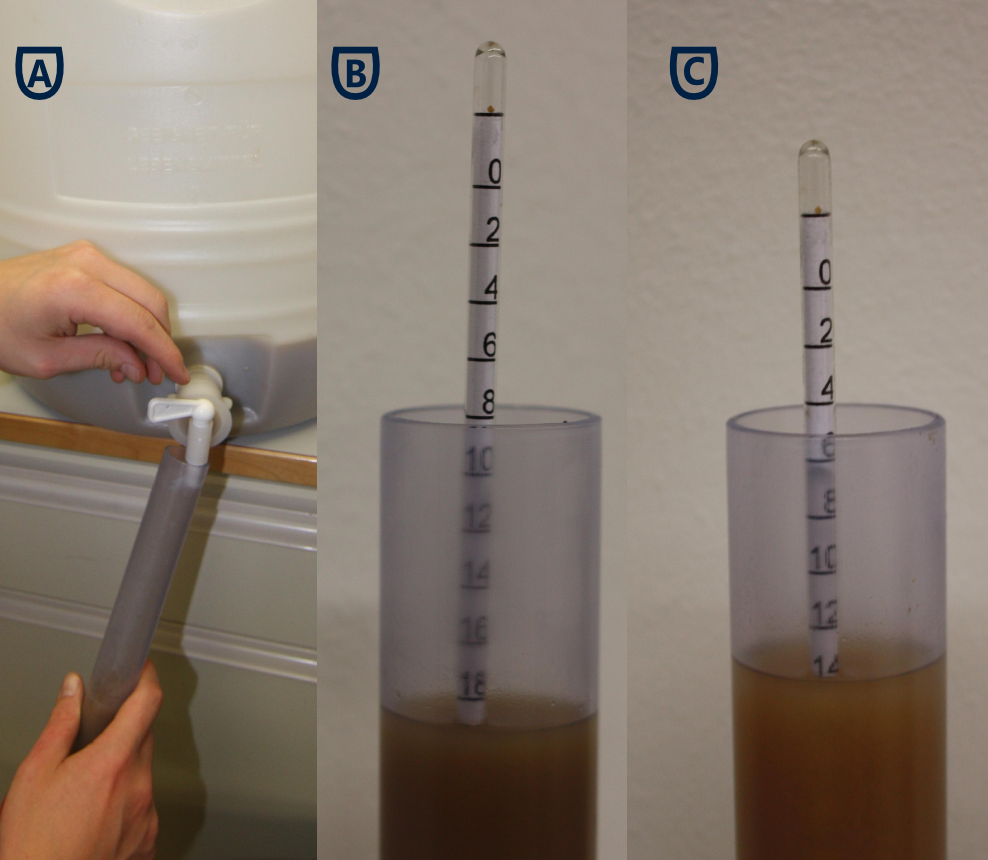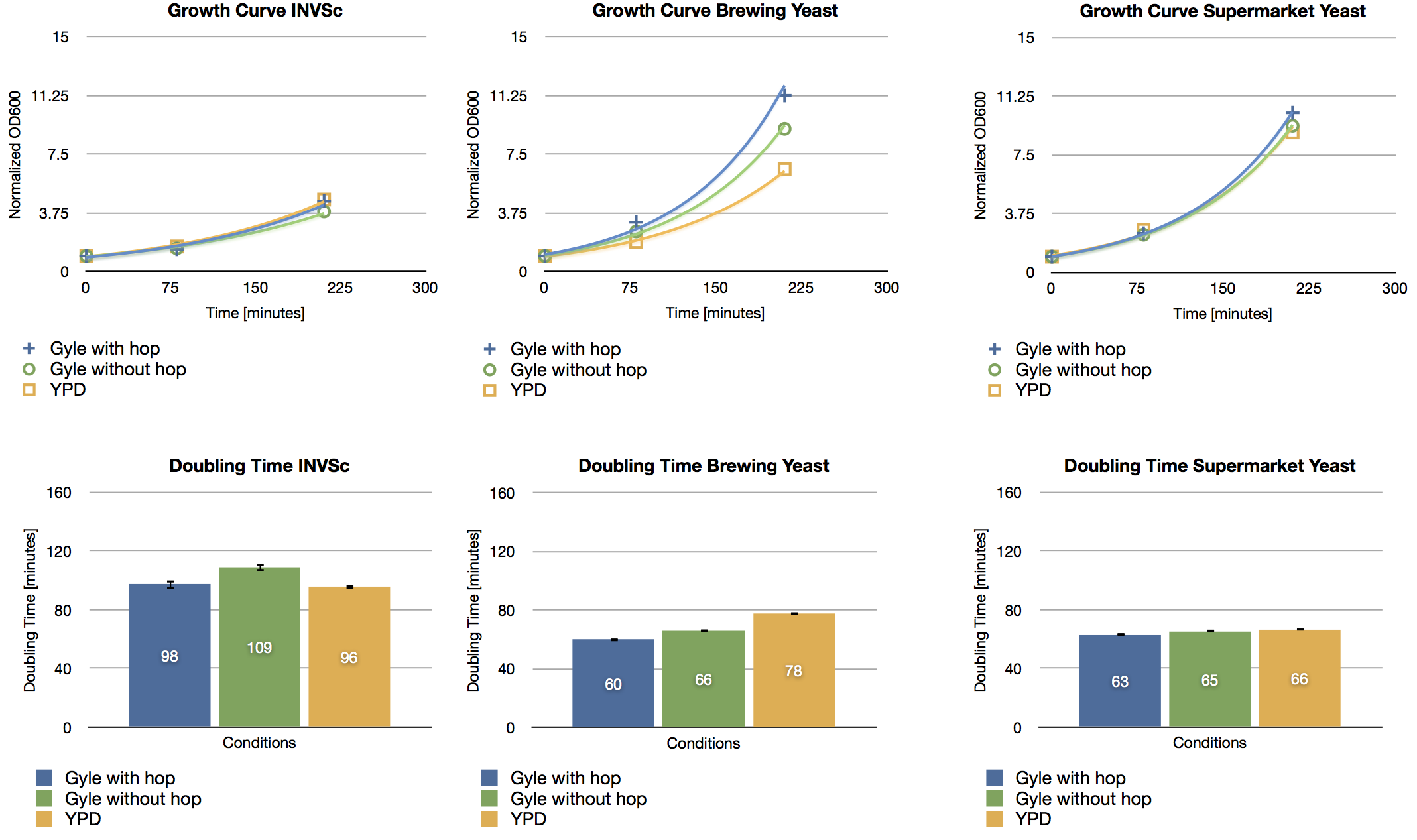Team:TU Munich/Project/Brewing
From 2012.igem.org
(Difference between revisions)
(→Preparation of the Mash) |
(→Preparation of the Mash) |
||
| Line 23: | Line 23: | ||
#'''(1A)''' We start by filling 20L water in a steel pot and heating it to about 50°C and then add 4-5kg of shredded malt. If you are in possession of a special bag for mash, a so called "Maischesack", you can fill the malt in the bag and hang it into the pot. Mind that the bag should not touch the bottom of the pot, as this could lead to burning of the bag and result in a slightly burned taste. | #'''(1A)''' We start by filling 20L water in a steel pot and heating it to about 50°C and then add 4-5kg of shredded malt. If you are in possession of a special bag for mash, a so called "Maischesack", you can fill the malt in the bag and hang it into the pot. Mind that the bag should not touch the bottom of the pot, as this could lead to burning of the bag and result in a slightly burned taste. | ||
| - | |||
| - | |||
#'''(1B)''' We keep up the temperature of 50°C and continuously stir the mixture for 30 minutes. During these 30 minutes proteaeses will decompose proteins contained in the shredded malt. After those 30 minutes we heat the mixture to 63°C and keep up this temperature for 60 minutes. Subsequently we heat to 73°C and keep stirring continuously. | #'''(1B)''' We keep up the temperature of 50°C and continuously stir the mixture for 30 minutes. During these 30 minutes proteaeses will decompose proteins contained in the shredded malt. After those 30 minutes we heat the mixture to 63°C and keep up this temperature for 60 minutes. Subsequently we heat to 73°C and keep stirring continuously. | ||
| - | |||
| - | |||
[[file:TUM12_Beer_iodine.png|300px|right|thumb|'''Figure 4.''' Four succeeding samples from from an iodine test]] | [[file:TUM12_Beer_iodine.png|300px|right|thumb|'''Figure 4.''' Four succeeding samples from from an iodine test]] | ||
| - | |||
[[file:TUM12_Beer_degree_determ.png|300px|right|thumb|'''Figure 3.''' Measurement of wort]] | [[file:TUM12_Beer_degree_determ.png|300px|right|thumb|'''Figure 3.''' Measurement of wort]] | ||
| - | |||
#'''(1C)''' The next step is the iodine test, to we verify whether starch was completely converted to sugar. We remove a small sample of mash and add iodine. A resulting blue-violet coloring indicates that there is still some leftover starch so the temperature of 73°C is kept up and this step is repeated until no staining is visible. | #'''(1C)''' The next step is the iodine test, to we verify whether starch was completely converted to sugar. We remove a small sample of mash and add iodine. A resulting blue-violet coloring indicates that there is still some leftover starch so the temperature of 73°C is kept up and this step is repeated until no staining is visible. | ||
| - | |||
As soon as the iodine does not cause any stain, the mash is heated to 78°C for 90 minutes, again under continuouos stirring. | As soon as the iodine does not cause any stain, the mash is heated to 78°C for 90 minutes, again under continuouos stirring. | ||
| - | |||
| - | |||
#'''(1D/E)''' The next step in the procedure is the lautering: a lautering cloth is strained over the opening of a large plastic pot and all the mash is filtered through this cloth. As all the malt will be filtered out in this step the lautering cloth needs to be well fixated to the plastic pot as it will need to carry weights of up 5kg. | #'''(1D/E)''' The next step in the procedure is the lautering: a lautering cloth is strained over the opening of a large plastic pot and all the mash is filtered through this cloth. As all the malt will be filtered out in this step the lautering cloth needs to be well fixated to the plastic pot as it will need to carry weights of up 5kg. | ||
| - | |||
| - | |||
#'''(3A-C)''' The filtrate, the so called gyle, should now have a wort of about 12%. The wort is measured with the help of a refractometer or an hydrometer. If the target of 12% is not reached, hot water should be filtered through the mash and the lautering cloth until 12% wort are attained. | #'''(3A-C)''' The filtrate, the so called gyle, should now have a wort of about 12%. The wort is measured with the help of a refractometer or an hydrometer. If the target of 12% is not reached, hot water should be filtered through the mash and the lautering cloth until 12% wort are attained. | ||
| - | |||
| - | |||
#'''(1F)''' Eventually the mash should be filled back into the steel pot, after carefully cleaning it. | #'''(1F)''' Eventually the mash should be filled back into the steel pot, after carefully cleaning it. | ||
Revision as of 19:41, 25 September 2012



Brewing
Contrary to popular opinion, the chief ingredient of beer is not YPD but gyle, a carefully prepared mixture of malt, hop, barley and water. Although the name S. cerevisiae suggests that it is used in the beer brewing process, in fact the yeast employed in brewing have strongly adapted to gyle, as they are reutilized in every succeeding brewing cycle. Hence some investigation on how our yeast performs in gyle was necessary.
Description idea.
- Does our laboratory streain of yeast survive the conditions of "the brewing-media"
- Are the substances that shall be produced by the yeast toxic and where is the toxic concentration.
- Try a brew with yeast having the expression cassetts on transient transfected vector.
- Try a brew with yeast having the expression cassetts stabely integrated in the genome.
The Brewing Process
Preparation of the Mash
- (1A) We start by filling 20L water in a steel pot and heating it to about 50°C and then add 4-5kg of shredded malt. If you are in possession of a special bag for mash, a so called "Maischesack", you can fill the malt in the bag and hang it into the pot. Mind that the bag should not touch the bottom of the pot, as this could lead to burning of the bag and result in a slightly burned taste.
- (1B) We keep up the temperature of 50°C and continuously stir the mixture for 30 minutes. During these 30 minutes proteaeses will decompose proteins contained in the shredded malt. After those 30 minutes we heat the mixture to 63°C and keep up this temperature for 60 minutes. Subsequently we heat to 73°C and keep stirring continuously.
- (1C) The next step is the iodine test, to we verify whether starch was completely converted to sugar. We remove a small sample of mash and add iodine. A resulting blue-violet coloring indicates that there is still some leftover starch so the temperature of 73°C is kept up and this step is repeated until no staining is visible.
As soon as the iodine does not cause any stain, the mash is heated to 78°C for 90 minutes, again under continuouos stirring.
- (1D/E) The next step in the procedure is the lautering: a lautering cloth is strained over the opening of a large plastic pot and all the mash is filtered through this cloth. As all the malt will be filtered out in this step the lautering cloth needs to be well fixated to the plastic pot as it will need to carry weights of up 5kg.
- (3A-C) The filtrate, the so called gyle, should now have a wort of about 12%. The wort is measured with the help of a refractometer or an hydrometer. If the target of 12% is not reached, hot water should be filtered through the mash and the lautering cloth until 12% wort are attained.
- (1F) Eventually the mash should be filled back into the steel pot, after carefully cleaning it.
Brewing the beer
- sdfsdf
Results
Experiment 1: Survival and growth of different yeast strains under various conditions
Experiment 2: Toxic concentration of the substances to be produced
Experiment 3: Experiments with expression cassetts on a transient transfected vector
Experiment 4: Expression cassetts stabely integrated in the genome
 "
"




